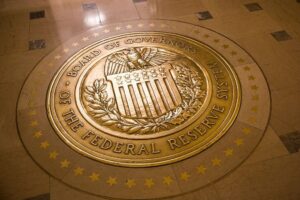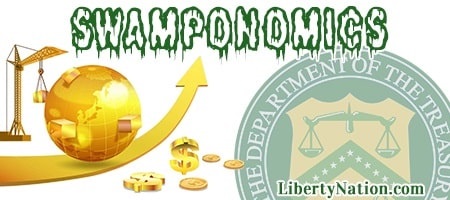Like the global de-dollarization campaign, the rise of central bank digital currencies (CBDCs) might turn out to be the biggest long-term threat to America’s fabric. Across the globe, CBDCs have been gaining exceptional popularity, and many experts aver that the United States needs to catch up to its peers, particularly China. But while the White House and the Federal Reserve are putting the pedal to the metal on the digitization of the dollar, one prominent think tank warns it could leave Americans’ “core freedoms” vulnerable.
Cato: Beware CBDCs
CBDC proponents have asserted that employing these monetary instruments provides a broad array of benefits, from technological innovation to faster payment speeds. However, a new report by Cato Institute, a conservative-libertarian hybrid think tank, contends that a government-issued digital currency imposes considerable costs on the American people. According to the paper by Nicholas Anthony and Norbert Michel, CBDCs threaten the US economic system. Moreover, researchers concluded that a digital dollar would “endanger Americans’ core freedoms” and possess zero upsides for financial privacy or personal liberty.
“As entrenched as this effort may already be, a U.S. CBDC would ultimately usurp the private sector and endanger Americans’ core freedoms,” the report stated. “Therefore, it should have no place in the American economy. Congress should explicitly prohibit the Federal Reserve and the Department of the Treasury from issuing a CBDC in any form.”
Despite the consternation surrounding CBDCs, they are becoming more prevalent worldwide. It is estimated that more than 100 nations are studying, experimenting, and implementing digital versions of their currencies. The one positive component in this global development has been the lackluster adoption rates, based on data and reports from places like China and Nigeria. So, how would consumers respond if the US offered digital alternatives to Benjamin Franklins and Thomas Jeffersons?
Cato’s analysis of more than 2,000 comment letters addressed to the Eccles Building revealed that the majority expressed concerns surrounding CBDCs potentially posing “a substantial threat to financial privacy, financial freedom, and the very foundation of the banking system.”
About That Fed Balance Sheet

(Photo by Brooks Kraft/ Getty Images)
It has been about a year since the Federal Reserve started reducing its astronomical $9 trillion balance sheet. The central bank’s runoff has been a slow and steady approach, as it declined only about $600 billion, despite exploding nearly $3 trillion in a three-month span in the early days of the coronavirus pandemic. Once the banking crisis started, the trend reversed, sending it back to a five-month high.
After the roughly $400 billion increase in a two-week period in March, which increased the balance sheet to above $8.7 trillion, the central bank has reignited the chief component of quantitative tightening. For the weeks ending March 29 and April 5, the Fed has lowered the ledger by approximately $100 billion. Today, it stands at $8.632 trillion.
So, what were some of the key revelations in the latest H.4.1. report? Holdings of Treasury securities fell, mortgage-backed securities were unchanged, the new crisis-era Bank Term Funding Program swelled, and “other credit extensions” surged. Although central banks worldwide have been accumulating gold, the Fed has failed to add to its yellow metal holdings yet again.
For the Love of Gold
What is the deal with gold prices these days? The shiny metal is glittering again in the financial markets as it trades above $2,000. The front-month futures contract recorded a weekly gain of nearly 2% and is up close to 11% year-to-date on the COMEX division of the New York Mercantile Exchange. Market analysts are confident that there is more room for growth in the yellow metal this year. But why? There is a trifecta of developments supporting gold.
 First, the US Dollar Index (DXY), a gauge of the greenback against a basket of currencies, is down about 1.4% this year. This is bullish for commodities priced in dollars, like gold and silver, since it makes it cheaper for foreign investors to purchase. Second, the US central bank is widely expected to slash interest rates sometime in the second half of 2023 or heading into 2024 in response to slowing economic growth. This is crucial because the movement in interest rates can affect the opportunity cost of holding non-yielding bullion. Lastly, recession fears have been resuscitated in the past month, driven by abysmal economic data and turmoil in the banking sector.
First, the US Dollar Index (DXY), a gauge of the greenback against a basket of currencies, is down about 1.4% this year. This is bullish for commodities priced in dollars, like gold and silver, since it makes it cheaper for foreign investors to purchase. Second, the US central bank is widely expected to slash interest rates sometime in the second half of 2023 or heading into 2024 in response to slowing economic growth. This is crucial because the movement in interest rates can affect the opportunity cost of holding non-yielding bullion. Lastly, recession fears have been resuscitated in the past month, driven by abysmal economic data and turmoil in the banking sector.
Gold failed to surpass its all-time high of $2,069.40 enjoyed in August 2020. However, with a combination of factors, from an economic downturn to the possibility of a lower benchmark policy rate, the precious metal could flirt with record highs throughout the year. This is good gold-fashioned economics for the 5,000-year-old commodity.
Please respect our republishing guidelines. Republication permission does not equal site endorsement. Click here.

